NOTE: If your device can not display the entire
description, you can find the logging questions listed in the
hint.
You are standing
in front of a building made from Concord Granite
Granite
Granite is a coarse-grained light colored
igneous rock composed mainly of feldspars and quartz which together
make up 90% of the rock. Quartz ranges from 20-45% and feldspar up
to 60% of the granite. It is the interlaced crystals of feldspar
and quartz, two very hard minerals, that gives granite it strength
and makes it such a good building material. Granite also has a
varying amount of other minor minerals, such as the black mica
biotite, and the black amphibole hornblende, both of
which gives granite its classic salt and pepper appearance.
The color of granite can range from pink to
cream, white and grey; and depends on the type of feldspar that
predominates. The potassium-rich orthoclase feldspar, has a salmon
pink color, while sodium-rich plagioclase feldspar, is white to
gray.
Granite is classified as igneous, arising from
magma many miles below the surface. Granite formation begins when
two tectonic plates collide. One plate will be pushed under the
other creating a subduction zone. Rocks in the down-going plate are
super-heated under extreme pressure, up to 1,600 degrees C, melting
into magma which then rises upwards because it is hot and less
dense than the surrounding material. About 10% of the magma will be
pushed to the surface, erupting as volcanoes where rapidly cooling
lava creates a variety of fine-grained rocks from basalt to
obsidian. However, 90% of the magma will remain deep below the
surface cooling slowly over a long period of time forming irregular
masses of granite, which can be extremely variable in size, ranging
from less than a few square miles to larger masses (batholiths)
that are often hundreds or thousands of square miles in area.
Beneath every mountain range formed over a subduction zone lies a
hudge bed of granite. Over eons, uplift and erosion removes miles
of bedrock to expose the granite domes.
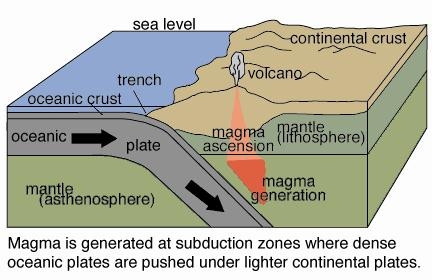
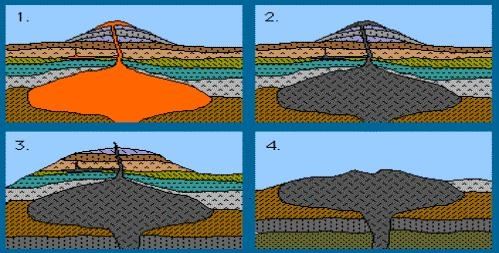
1) A magma chamber forms; 2) slowly cools; 3)
continued uplifting from tectonic action forms mountains; 4)
erosion and continental glaciers scour the earth exposing the
granite dome at the surface.
The crystalline structure gives Granite its
name, from the Latin granum meaning grain. Granite can be
classified as fine-grained, medium-grained (in which the feldspar
crystals average about ¼ inch in diameter), or coarse-grained. The
size of the grain is related to how long the magma took to cool,
the slower the cooling the longer the minerals have to develop
larger crystals.
The Granite State
New Hampshire is nicknamed the Granite State,
but not because the predominant rock is granite. Although many of
the White Mountains are indeed granite, among our most famous
mountains, neither Mount Washington, the rest of the Presidential
Range, nor Mount Monadnock are made of granite. These mountains are
made from the very erosion resistant schists of the Littleton
Formation, but that’s another story.
New Hampshire became known as the Granite State
mainly due to the 19th Century building boom in Boston, New York
City and Washington, D.C. Other smaller cities and towns also used
New Hampshire granite in municipal buildings for monuments, and
curbs. There were two of types of local granite that were quarried
extensively and shipped widely, spreading the fame of New
Hampshire's granite. One is the pink colored Conway Granite (Cannon
Mountain and the ledges that made up The Old Man of the Mountains
are composed of Conway Granite); and the other is the gray colored
Concord Granite. Both granites got their names from the towns in
which they were first quarried.
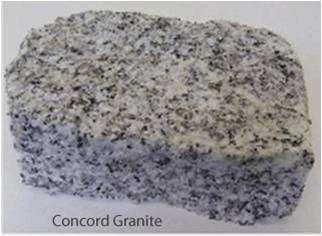
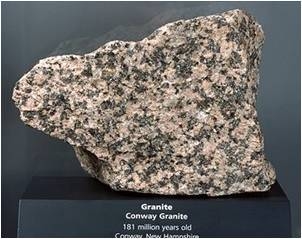
The Building
The New Hampshire State House is the state
capitol building of New Hampshire, and houses the New Hampshire
General Court, Governor and Executive Council. The State House is
the oldest state capitol in which the legislature meets in its
original chambers.
The building was built from 1816 to 1819 in the
Greek Revival style. The entrance is covered by a small projecting
portico supported by Doric columns. The balcony above is lined with
a balustrade separated by Corinthian columns supporting a pediment.
Another balustrade lines the edge of the flat roof. The windows on
the first floor are rectangular in shape, the second floor windows
are arched and the third floor are square panels. An octagonal drum
with large arched windows supports a golden dome with bull's-eye
windows and supporting a small lantern. A statue of a huge
gold-painted wooden war eagle looking to the left was raised during
1818. During 1957, it was replaced with an element-proof peace
eagle statue looking to the right, with the original eagle given to
the New Hampshire Historical Society. The building was enlarged and
remodeled in 1866.
Granite used to build the capitol came from the
present-day Swenson quarries; the cutting, shaping and facing of
the stone was performed by inmates of the State Prison.
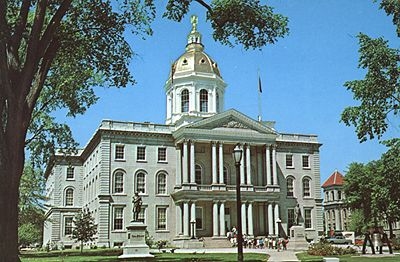 The
Quarry
The
Quarry
Concord Granite comes from a quarry on the side
of Rattlesnake Hill, above North Main St in Concord. In the late
1800’s, three large boulders were discovered and purchased
for the purpose of producing granite monuments. By 1900, 44
separate stone companies were pulling granite from the quarries on
Rattlesnake Hill. The Swenson Granite Company eventually purchased
all of the other regional quarries. The Swenson Company has
provided granite for numerous monuments and famous buildings around
the country. These include Boston's Quincy Market, the Tomb of the
Unknown Soldier, and the Pentagon.
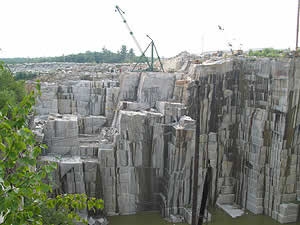
If you want to get a closer look at the quarry, check out these
three caches on Rattlesnake Hill:
Old Quarry--Old Quarry Hens
Quarry Dogs
Rock Pile for Smiles
Caveat emptor. It is common in the building
trades to lump a wide variety of rock types under the name
"granite." Commercial granite can be any crystalline rock that is
harder than marble with large mineral grains.
Logging Requirements:
1. Please examine the Concord Granite on the
outside of the State House. How would you classify its grain:
small, medium or large?
2. Look at the granite closely, can you see any color? Does it
contain any orthoclase feldspar?
3. At the Northeast corner of the building, you will find a plaque
commemorating the visit of a Revolutionary War hero. There is a
well known mountain in New Hampshire that bears his name. What type
of rock is that mountain primarily made of?